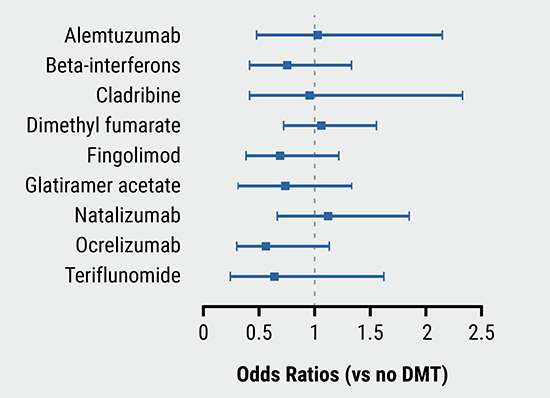https://doi.org/10.55788/ae0e8e78
Rituximab is often prescribed off-label in the early stages of AQP4+ NMOSD. However, patients often need to switch to more efficacious therapies to prevent relapse, most notably C5ITs like eculizumab and ravulizumab.
The phase 3 studies PREVENT (NCT01892345) and CHAMPION-NMOSD (NCT04201262) evaluated the safety and efficacy of eculizumab and ravulizumab, respectively, in adult patients with AQP4+ NMOSD [1,2]. A pooled post-hoc analysis compared safety outcomes between patients who had and had not received prior rituximab treatment within 3–12 months of starting a C5IT [3]. The authors analysed treatment-emergent adverse events (TEAEs), treatment-emergent serious adverse events (TESAEs), and deaths or withdrawals due to TEAEs.
Of the 154 actively treated patients in PREVENT and CHAMPION-NMOSD, 38 (24.7%) had used rituximab within 3–12 months prior to the first C5IT dose, whereas 116 (75.3%) had not. In both groups, the mean number of relapses in the year prior to screening for the trial was 2.0; they also had similar historical annualised relapse rates.
The incidence of patients experiencing TEAEs and TESAEs was generally similar in patients with prior and no prior rituximab use: TEAEs 94.7% versus 90.5%, and TESAEs 21.2% versus 24.1%, respectively. Most TEAEs were mild or moderate in severity and deemed unrelated to the C5IT. The most common types of TEAE were infection and infestation: 71.1% versus 71.6%, respectively. Headache and upper respiratory tract infections were more common in patients with no prior rituximab use, while urinary tract infection occurred more frequently in patients with prior rituximab exposure. In the prior-rituximab group, 15 of 413 events were TESAEs; 13 were considered unrelated to the study drug. No patients experienced a TEAE or TESAE leading to C5IT withdrawal in this group.
- Pittock SJ, et al. Ann Neurol. 2023;93:1053–1068.
- Pittock SJ, et al. N Engl J Med. 2019;381:614–625.
- Levy M, et al. Safety findings in patients with AQP4+ NMOSD who received eculizumab or ravulizumab in the PREVENT and CHAMPION-NMOSD studies and had received rituximab within 1 year prior to enrolment. P378, MSMilan 2023, 11–13 October, Milan, Italy.
Copyright ©2023 Medicom Medical Publishers
Posted on
Previous Article
« Telerehabilitation effective in improving MS symptoms in patients with moderate disability Next Article
Sickness absence rate increases years before clinical onset of MS »
« Telerehabilitation effective in improving MS symptoms in patients with moderate disability Next Article
Sickness absence rate increases years before clinical onset of MS »
Table of Contents: MSMilan 2023
Featured articles
Letter from the Editor
Real-world data supports ocrelizumab prior to conception
Progressive MS
Early initiation of highly active treatment associated with a lower risk of SPMS
Ocrelizumab more effective than interferon/glatiramer acetate in older MS patients
Paediatric MS
Prioritising high efficacy therapies in children with MS
Omega-3 polyunsaturated fatty acids associated with lower risk of MS activity
NMOSD & MOGAD
An update on evolving treatment algorithms for NMOSD and MOGAD
Women’s Health
Rate of grey matter brain atrophy accelerates after menopause
Real-world data supports ocrelizumab prior to conception
Miscellaneous
New insights into the contribution of EBV to MS pathogenesis
COVID-19 infection associated with higher MS relapse rate
Telerehabilitation effective in improving MS symptoms in patients with moderate disability
Curing MS
Understanding what an MS cure means and what it takes
Prodromal MS
Progressive brain tissue loss precedes the onset of clinical MS by years
Sickness absence rate increases years before clinical onset of MS
Treatment Trials and MS Strategies
Early intensive treatment enhances long-term clinical outcomes
Oral glycolipid shows promise in the treatment of MS, especially SPMS
Fenebrutinib shows rapid reduction of new Gd+ T1 lesions
Challenges of de-escalation versus discontinuation of highly effective DMTs in older MS patients
Biomarkers & Imaging
χ-separation can assess the effects of tissue destruction in early MS lesions
High sGFAP levels are associated with disease progression, independent of NfL or relapse activity
Broad rim lesions correlate with a rapidly progressive MS phenotype
Smouldering inflammation detectable even in the earliest stages of MS
Related Articles
December 9, 2021
Evobrutinib reduces relapses and MRI lesion activity

November 25, 2020
Risk of COVID-19 not increased in MS patients
November 25, 2020
Age and EDSS are risk factors for severe COVID-19
© 2024 Medicom Medical Publishers. All rights reserved. Terms and Conditions | Privacy Policy
HEAD OFFICE
Laarderhoogtweg 25
1101 EB Amsterdam
The Netherlands
T: +31 85 4012 560
E: publishers@medicom-publishers.com

